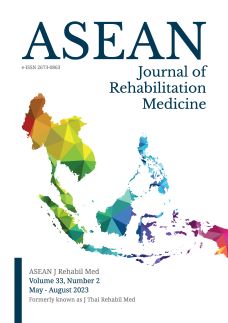Evertor Muscle Function as a Predictor of Recurrence of Deformity Following Treatment of Pediatric Idiopathic Clubfoot, A Cohort Study
Keywords:
recurrent clubfoot, evertor muscle function, evertor muscle gradingAbstract
Objectives: This study aimed to evaluate the relationship between evertor muscle function and the recurrence of deformity following treatment of pediatric idiopathic clubfoot.
Study design: A cohort study.
Setting: Maharat Nakhon Ratchasima hospital, Nakhon Ratcha-sima province, Thailand.
Subjects: Sixty-two children with idiopathic clubfoot.
Methods: Children with idiopathic clubfoot who were treated and followed up at Maharat Nakhon Ratchasima hospital, Thailand for a minimum of 2 years were enrolled. After the initial success of serial manipulation and plaster casting, parents were advised regarding the child’s foot evertor muscle training and Achilles and tibialis posterior tendon stretching exercises without using the Denis Browne bar. Demographic data included age at onset, gender, Dimeglio score, number of casts required for initial correction, the need for Achilles tenotomy, and evertor muscle grading before and after training. All children were evaluated regularly for signs of recurrence. Univariate analysis was used to analyze the relative risk of recurrence with good and poor evertor muscle function.
Results: Sixty-two children with clubfoot, 42 males (67.7%) and 20 females (32.3%) were enrolled. Twenty-six (41.9%) children had bilateral deformities. Recurrence of deformities after treatment was documented in 22 children (35.5%). Severe deformity at presentation according to the Dimeglio score was a significant predictor of recurrence (p 0.012). After adjusting for relative risk base on the Dimeglio score, the recurrence was significantly higher in the poor evertor muscle function group with an adjusted RR of 9.59 (95%CI 3.43 - 26.80).
Conclusions: Evertor muscle function is associated with the recurrence rate of pediatric idiopathic clubfoot.
References
Ignacio V. Ponseti. Congenital clubfoot: fundamentals of treatment. Michigan: Oxford University Press; 1996. p. 140.
Herzenberg JE, Radler C, Bor N. Ponseti versus traditional methods of casting for idiopathic clubfoot. J Pediatr Orthop [Internet]. 2002 Jul-Aug [cited 2021 Feb 21];22(4):517-21. Available from: http://pubmed.ncbi.nih.gov/12131451/ doi: 10.1097/01241398-200207000-00019
Changulani M, Garg NK, Rajagopal TS, Bass A, Nayagam SN. Sampath J, et al. Treatment of idiopathic club foot using the Ponseti method, initial experience. J Bone Joint Surg [Br] [Internet]. 2006 Oct [cited 2021 Feb 21];88(10):1385-7. Available from: http://pubmed.ncbi.nih.gov/17012432/ doi: 10.1302/0301-620X.88B10.17578
Chotel F, Parot R, Seringe R, Berard J, Wicart P. Comparative study: Ponseti method versus French physiotherapy for initial treatment of idiopathic clubfoot deformity. J Pediatr Orthop [Internet]. 2011 Apr-May [cited 2021 Feb 21];31(3):320-5. Available from: http://pubmed.ncbi.nih.gov/21415694/ doi: 10.11097/BPO.0b013e31820f77ba
Chu A, Lehman WB. Persistent clubfoot deformity following treatment by the Ponseti method. J Pediatr Orthop B [Internet]. 2012 Jan [cited 2021 Feb 21];21(1):40-6. Available from: http://pubmed.ncbi.nih.gov/22134651/ doi: 10.1097/BPB.0b013e32834ed9d4
Dobbs MB, Rudzki JR, Purcell DB, Walton T, Porter KR, Gurnett CA. Factors predictive of outcome after use of the Ponseti method for the treatment of idiopathic clubfeet. J Bone Joint Surg [Am] [Internet]. 2004 Jan [cited 2021 Feb 21];86(1):22-7. Available from: http://pubmed.ncbi.nih.gov/14711941/ doi: 10.2106/00004623-200401000-00005
Haft GF, Walker CG, Crawford HA. Early clubfoot recurrence after use of the Ponseti method in a New Zealand population. J Bone Joint Surg [Am] [Internet]. 2007 Mar [cited 2021 Feb 21];89(3):487-93. Available from: http://pubmed.ncbi.nih.gov/17332096/ doi: 10.2106/JBJS.F.00169
Azarpira MR, Emami MJ, Vosoughi AR, Rahbari K. Factors associated with recurrence of clubfoot treated by the Ponseti method. World J Clin Cases [Internet]. 2016 Oct [cited 2021 Feb 21];4(10):318-22. Available from: http://pubmed.ncbi.nih.gov/pmc/articles/PMC5067494/ doi: 10.12998/wjcc.v4.i10.318
Gelfer Y, Dunkley M, Jackson D, Armstrong J, Rafter C, Parnell E, et al. Evertor muscle activity as a predictor of the mid-term outcome following treatment of the idiopathic and non-idiopathic clubfoot. Bone Joint J [Internet]. 2014 Sep [cited 2021 Jun 2];96-B(9):1264-8. Available from: http://pubmed.ncbi.nih.gov/25183601/ doi: 10.1302/0301-620X.96B9.33755
Eamsobhana P, Kongwachirapaitoon P, Kaewpornsawan K. Evertor muscle activity as a predictor for recurrence in idiopathic clubfoot. Eur J Orthop Surg Traumatol [Internet]. 2017 Oct [cited 2021 Jun 2];27(7):1005-9. Available from: http:/ /pubmed.ncbi.nhm.nih.gov/28528482/ doi: 10.1007/s00590-017-1975-z
Lewsirirat S, Piyapromdee U, Klongkaew P. An alternative treatment for clubfoot in infants: an evaluation of the Korat technique of serial casting with and without early percutaneous needle Achilles tenotomy. J Med Assoc Thai [Internet]. 2018 March [cited 2021 Jun 2];101(3):23-34. Available from: http://www.jmatonline.com/index.php/jmat/article/view/ 9533
Zionts LE, Dietz FR. Bracing following correction of idiopathic clubfoot using the Ponseti method. J Am Acad Orthop Surg [Internet]. 2010 August [cited 2022 Aug 8];18(8):486-93. Available from: http://pubmed.ncbi.nih.gov/20675641/ doi: 10.5435/00124635-201008000-00005
Edmonds EW, Frick SL. The drop toe sign: an indicator of neurologic impairment in congenital clubfoot. Clin Orthop Relat Res [Internet]. 2009 May [cited 2022 Aug 8]; 467(5):1238-42. Available from: http://pubmed.ncbi.nih.gov/19130157/ doi: 10.1007/s11999-008-0690-9
Feldbrin Z, Gilai AN, Ezra E, Khermosh O, Kramer U, Wientroub S. Muscle imbalance in the aetiology of idiopathic club foot. An electromyographic study. J Bone Joint Surg [Br] [Internet]. 1995 July [cited 2022 Aug 8];77(4):596-601. Available from: http://pubmed.ncbi.nih.gov/7615605/ doi: 10.1302/0301-620X.77B4.7615605
Little Z, Yeo A, Gelfer Y. Poor evertor muscle activity is a predictor of recurrence in idiopathic clubfoot treated by the Ponseti method: a prospective longitudinal study with a 5-year follow-up. J Pediatr Orthop [Internet]. 2019 July [cited 2022 Aug 8];39(6):e467-e471. Available from: http://pubmed.ncbi.nih.gov/30855553/ doi: 10.1097/BPO.0000000000001357
Gray K, Burns J, Little D, Bellemore M, Gibbons P. Is tibialis anterior tendon transfer effective for recurrent clubfoot? Clin Orthop Relat Res [Internet]. 2014 Feb [cited 2022 Aug 8];472(2):750-8. Available from: http://pubmed.ncbi.nih.gov/24061847/ doi: 10.1007/s11999-013-3287-x
Downloads
Published
How to Cite
Issue
Section
License

This work is licensed under a Creative Commons Attribution-NonCommercial-NoDerivatives 4.0 International License.






